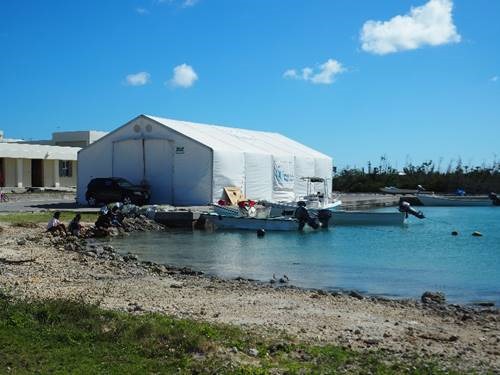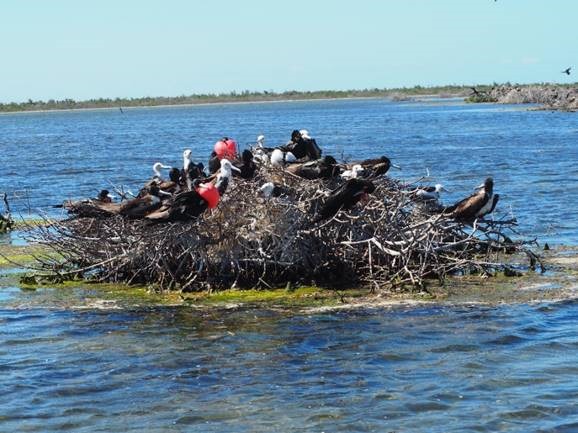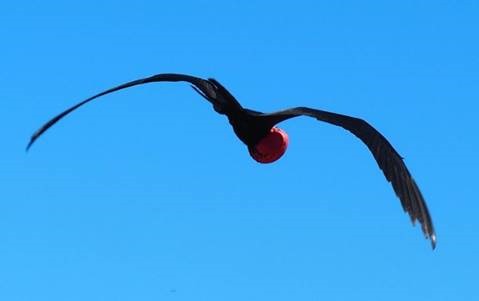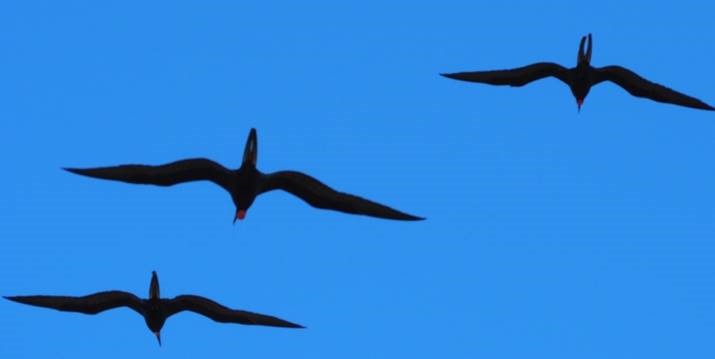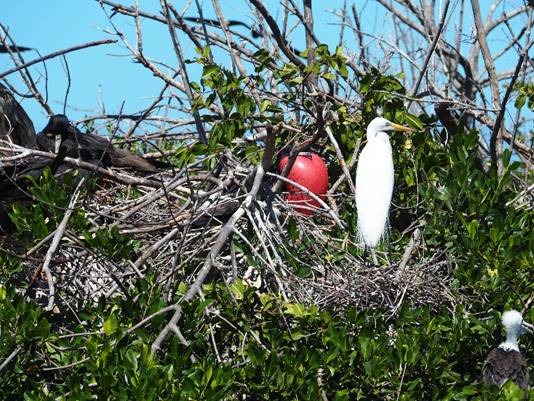20 Feb ... and chasing chicks in Barbuda

|
17:39N 61:51.4W The following morning we raided the Jolly Harbour supermarket in the hope of finding a few non-essentials and eventually set sail for Barbuda at 10am. The wind was a blustery 20 – 25 knots from the starboard bow, throwing up confused 2m seas, but we managed to make the south west corner of the island in one tack at a good speed, albeit well reefed. Barbuda is a very low-lying island and we only made landfall when it was 6 miles away – you could see Antigua, Montserrat and Redonda clearly, more than 30 miles astern. Once in the lee of the island, the depth dropped to around 4m and the sea colour reverted to Finest Caribbean Turquoise. The west side of the island is called ’11 Mile Beach’ for a good reason – wonderful golden-white sand stretching as far as the eye can see. Except that since Hurricane Irma, the beach has been breached in the middle and there is now a gap about half a mile wide by the ruined Palm Hotel and opposite the town of Codrington, across the far side of the Codrington Lagoon.
Trashed hotel on the beach at Barbuda. The owner clings grimly to his dream on the top floor… We anchored just north west of the breach in 3m of quite cloudy water. The top floor of the small hotel appeared to be occupied, but the building is very badly damaged and I can only think that it will have to be demolished. It was strongly built of concrete, but its foundations are on sand (heard that anywhere before?). We learnt that at the height of the storm, sea levels rose by about 20 feet and this place must have worn the brunt of its fury… Just 30 miles to the south, Antigua was hardly affected by Irma; Barbuda was ravaged.
Eleven Mile Beach looks like this for… 10.5 miles since Irma cut a hole in the middle. On Wednesday we went ashore to Codrington. It was a wet, rough dinghy ride across the mile-wide lagoon, but we found a ready welcome from the locals. The town is an interesting mix of temporary buildings erected by aid agencies such as the World Food Programme, a lot of concrete or brick housing, some with new roofing, some with the ubiquitous blue tarpaulin, many just abandoned. The dockside seems in reasonable shape, but the main commercial quays are at the southern end of the island and we did not see them. Very few shops, not many people about. It reminded me of parts of Basra; tidier, less edgy, much sleepier. We met George, who agreed to take us to see the Magnificent Frigatebird colony at the northern end of the lagoon. We went for a wander round first whilst he dealt with some other visitors and eventually we met an elderly lady sitting by the side of the road selling fruit and vegetables. Hers were better than the ones in the Falmouth supermarket, so we bought some bananas and got talking. It was clear that without the Aid Agencies, very little help would have come to these people. She had nothing good to say about the Government in Antigua, which appears to have done very little to help reconstruction and has not paid any Public workers for three months. I’m not sure what the other side of the story is, but her assertions were echoed by another lady we met whilst queuing for some lunch in a tiny shack near the harbour. An Antiguan teaching here on Barbuda, she had not been paid since before Christmas…
Codrington waterfront, dominated by the Aid Agencies In the end, George did not take us to see the birds, but Pat did. We were joined by a Belgian couple who were on the catamaran next to us at anchor. The Barbudan Magnificent Frigatebird colony (there are five varieties of Frigatebird) turned out to be one of the highlights of our two-year deployment. We’ve seen these birds almost daily since arriving in the Caribbean: they tend to patrol high above us, swooping down to pick small fish off the surface of the water or steal food from an (aptly named) booby. Apparently they cannot swim or walk, but with a six-foot wingspan they can certainly fly! Most of the birds we see out at sea are females with white breasts; the juveniles have white breasts and heads; the males are all black and move from one colony to another to mate. They then stay around for a bit, acting as a house-husband whilst the female goes off in search of food. They live for up to 40 years. The male courting display involves inflating a huge, reddy-orange bladder under their gullet to attract the attention of a female. The mating season here on Barbuda runs from September to March. It’s an extraordinary sight.
2 adult males in ‘come hither’ mode, a couple of other males and a clutch of juveniles on a patch of dead mangrove they call ‘home’. The colony, numbering about 20,000, lives in the mangroves and Pat manoeuvred the boat to within a few feet of the birds, who seemed unperturbed by our presence. I couldn’t see much in the way of a nest, but they seemed secure enough in the mangroves, which were recovering from the hurricane. Interestingly the smell of guano wasn’t nearly as powerful as it is around a gannet colony, for example. Probably because the stuff all falls into the water.
‘Look at me!’ Apparently they all flew away before the hurricane hit and the vast majority seem to have returned, even though the mangroves they call home have taken a bit of a mauling.
I’m not sure this really aids his aerodynamics…?
Three males off for a cruise round after a hard morning nursing chicks On the way back to Codrington, we saw fishermen in amongst the mangroves, catching snapper with spears as well as a long net. They seemed to be doing better than our friends in Deshaies.
Fishermen in the mangroves, Barbuda Yesterday we left Barbuda and made passage to North Sound, Antigua. We could have stayed a bit longer and visited Cocoa Beach, where there’s a resort that was favoured by the late Princess of Wales, but we decided to make best use of our remaining time here to explore the north coast of Antigua. It was a rough, windy 30 mile passage, made under a small genoa only, with our speed never dropping below 7 knots. The north of the island is protected by a rash of coral reefs and outcrops, so we threaded our way carefully into Boon Channel and then motored directly upwind towards our destination, rather than short tacking in unfamiliar waters, with coral heads reported to be lurking all about as winds gusted over 30 knots… The pilot book, written by Chris Doyle, describes the anchorage in Jumbly Bay, Long Island as ‘exquisite’. It is certainly well sheltered, but the shoreline is completely occupied by a smart resort and some very well-manicured homes belonging to well-heeled Antiguans. Mere mortals cannot move beyond the high water mark and it reminded me of the snootier parts of the Chesapeake , Solomons for example, where it’s all very nice to look at but you hardly feel welcome by the locals. Still, we didn’t really mind. The weather wasn’t great, certainly not good enough to push further on into the reefs of North Sound and Hells’ Gate, but we were in a secure, sheltered anchorage for the night. Chris Doyle: please replace ‘exquisite’ with ‘useful’.
‘I’m sorry, Mate – you’re too fat like that.’ An egret appears unimpressed. Note the comical little chap bottom right.
|


